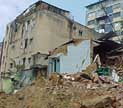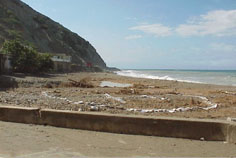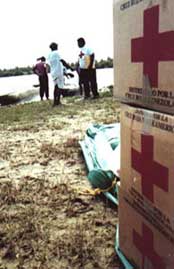 Written by
Cynthia
Long, Managing Editor, DisasterRelief.org
Written by
Cynthia
Long, Managing Editor, DisasterRelief.org
| PROJECT | SITE | IMAGES | NEWS | VENEZUELA |
 Written by
Cynthia
Long, Managing Editor, DisasterRelief.org
Written by
Cynthia
Long, Managing Editor, DisasterRelief.org
Three months after Venezuela's worst natural disaster in 50 years, the country is still struggling to recover. The news crews have left and the world has focused its attention on other crises, but thousands of people are still living in shelters after mudslides and floodwaters destroyed dozens of shantytowns along a 60-mile swath of the northern Caribbean coast.
"There is barely an unaffected person here, nearly everyone has lost either a friend, relative or colleague. Thousands of Venezuelans have sought support from the church and the support has not only been material, but emotional and spiritual as well," says John McCuen of Catholic Relief Services, one of the relief agencies assisting the Venezuela disaster victims.
 |
The damage is estimated at $3.2 billion, or 3.3 percent of the country's gross national product. Property and major infrastructure — such as dams, bridges, transportation and electricity services — make up about 60 percent of the direct damage. |
Hardest hit was the state of Vargas. Weeks of torrential December rains triggered avalanches of mud, rocks and trees that came roaring down the Avila Mountains, the majestic range that divides the capital city of Caracas from Vargas state. Countless mountainside slum dwellings were either buried in the mudslide or swept out to sea.
While Vargas was completely devastated and all of its surviving residents were evacuated from the region, some areas of Falcon state to the west were spared and the government set up shelters away from the destruction.
About 200,000 people are still living in temporary shelters or with relatives, receiving assistance from local authorities, churches, relief agencies and the military.
 |
Thousands of people are still without access to safe water and transportation to some affected areas continues to be a problem. |
Three months after the disaster people are still returning to their homes for the first time, looking for their relatives or to rescue some of their belongings buried in mud. Posters with photos of missing people are widespread in the streets. The majority of the affected people continue to live in the government shelters, and it is estimated that the resettlement process will last at least 10 more months.
Government Plans For Rebuilding
Early this week, Venezuela President Hugo Chavez announced an ambitious plan to restore Venezuela's northern coastal region. In a nationally televised speech, Chavez explained his strategy to spend more than 1 billion dollars to rebuild thousands of homes, expand the country's main airport and construct canals that can direct raging rivers away from communities.
 |
With funding help from the private sector, he said the government would build more than 40,000 new homes in the hard-hit state of Vargas. The government has asked experts from around the world to assess Vargas' needs and figure out how to rebuild out of potential danger zones. One proposal is to build huge canals in Vargas' towns and villages that can channel any future flooding. |
Using computer graphics and blueprints in his three-hour speech, Chavez laid out how the state of Vargas would be restructured. In two towns, Tanaguarenas and Los Corales, he said the government would expropriate land to build the canals. The resort towns of Macuto and Camuri Chico would be restored as tourist destinations for the capital city's 5 million residents, and $100 million would be spent to expand Venezuela's main international airport, including the construction of a new hotel. The country's main seaport, also in Vargas, also would be "modernized."
The towns utterly devastated by the disaster, where most structures were swept out to sea, will not be rebuilt at all, Chavez said. Instead, the towns — including the coastal community of Carmen de Uria — will be turned into parks, bathing resorts or other outdoor facilities.